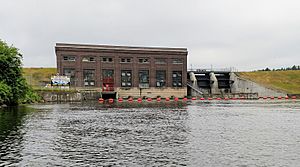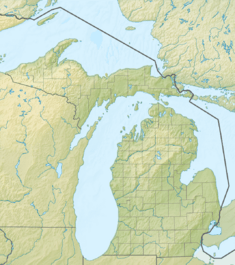Loud Dam facts for kids
Quick facts for kids Loud Dam |
|
|---|---|

Loud Dam Tailwater 2017
|
|
|
Location within the state of Michigan
|
|
| Location | Oscoda Township, Iosco County, Michigan |
| Coordinates | 44°27′49″N 83°43′20″W / 44.4635456°N 83.7222398°W |
| Opening date | 1913 |
| Owner(s) | Consumers Energy |
| Dam and spillways | |
| Type of dam | Embankment dam |
| Spillways | 3 |
| Power station | |
| Turbines | 2 Allis-Chalmers |
| Installed capacity | 4 MW |
The Loud Dam is a special kind of dam called a hydro-electric dam. It's built on the Au Sable River in Michigan. This dam helps make electricity using the power of flowing water.
You can find Loud Dam along the River Road Scenic Byway in Northern Michigan. This byway is a beautiful road listed on the National Register of Historic Places. It's a great spot to visit and see how nature and technology work together!
Contents
What is Loud Dam?
The Loud Hydroelectric Plant is a group of structures on the Au Sable River. It includes the main dam, which has strong earth walls on each side. These walls connect to a part called a spillway. The spillway helps control the water flow.
Near the spillway, you'll find the powerhouse. This is where the electricity is actually made. There's also an outdoor substation, which helps send the electricity out.
Visiting Loud Dam
If you want to visit, there's a boat ramp for public use. It's kept in good shape by Consumers Energy. This ramp lets you get onto Loud Pond.
If you're canoeing or kayaking, you can easily get around the dam. There are special paths called portage facilities. You can choose to portage on either the right or left side of the dam.
Portage Options
The right portage path is about 250 yards long. It's a gravel road that leads to a canoe slide. This slide helps you get your canoe or kayak back into the water below the dam.
The left portage is shorter but much steeper. It doesn't have any special facilities. You'll need to take your boat out at a steel platform. Then, you climb over a concrete fence to get past the dam.
Who is Loud Dam Named After?
Loud Dam is named after the Loud family, who were very important in the lumber business. Edward F. Loud was a key person in this family. He owned a lot of land along the Au Sable River in the early 1900s.
Edward Loud later worked with William Foote and others. Together, they helped build the hydro-electric dams on the Au Sable River. He sold his land to the power company in 1909.
The Loud Family Legacy
Edward F. Loud retired after helping to develop the river's power. He and his wife bought Loud Island. This was a 30-acre summer getaway on Van Etten Lake. It was only two miles from Lake Huron.
Edward's father was Henry M. Loud. He was a very rich lumber boss in the 1800s. Newspapers like The Detroit Free Press called his company, H.M. Loud Co., one of Michigan's wealthiest lumber businesses.
When Edward F. Loud passed away in 1952 at age 93, newspapers across the country wrote about him. The New York Times called him a "LUMBER 'KING'." The Daily News in New York City said he was "one of the last of Michigan's lumber kings."
How Loud Dam Works
Loud Dam can produce 4 megawatts of electricity. It was the third hydro-electric dam built on the Au Sable River by Consumers Power Company. It was finished in 1913.
Dam Structure and Power
The Loud Dam is an earth embankment dam. This means it's built mostly from earth. It has a strong concrete wall inside to hold back the water. This creates a water height difference of 27 feet.
The dam still uses its original equipment! This includes two large turbines made by Allis-Chalmers. Turbines are like big water wheels that spin when water flows through them. There are also two generators made by General Electric. Each generator makes 2,000 kilowatts of power.
The Powerhouse
The powerhouse is a rectangular building. It's 40 feet wide and 120 feet long. It has a flat roof and sits on a strong concrete base. This building protects the turbines and generators.
The spillway is made of concrete. It has three special gates called tainter gates. These gates can release a lot of water very quickly. They can let out 16,650 cubic feet of water every second.
Loud Dam in the Canoe Marathon
Loud Dam is one of six dams that canoe race teams must portage around. This happens during the Au Sable River Canoe Marathon. This race is 120 miles long and takes place overnight each summer.


